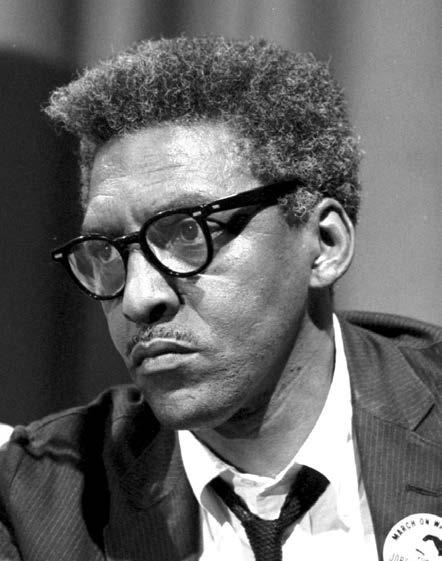
5 minute read
Civil Rights Leader Still Has Lessons to Teach Us
from The Contact 2-28-24
by okumc
BY REV. VALERIE STEELE
All the events swirling around the globe when Paul McCartney composed Let It Be perhaps encouraged him to write this song. When all is not well in the world, we want answers. For some individuals, those answers are demanded and vehemently sought. That is the intersection where real change for the good of humanity occurs.
Have you ever heard of Bayard Rustin?
Like so many hidden figures in history, it was not until decades later that current history lifted his story and accomplishments to the light of day. He was a proponent of nonviolence. He was a civil rights activist and one genius of an organizer.
the scenes, pushing others forward to the spotlight. He worked with some heavyweights of African American history such as A. Philip Randolph on the initial March on Washington in 1941. This effort demanded and led to the desegregation of the U.S. military. Yet, a literal march never occurred. He was a close family friend of the Kings (yes, that King family.) Working with the up and coming Dr. Martin Luther King, Jr., he organized the Southern Christian Leadership Conference. This was a busing laws. Although there was unprovoked violence and bloodshed by white mobs and mass arrests, a change did come.
While the 1941 March on Washington did achieve the results it sought, his crowning glory of a monumental movement was the 1963 March on Washington for Jobs and Freedom. Rustin organized this March with a group of young people seeking and demanding that this be a nation with liberty and justice for all. In the mix were some other behind-the-scenes veterans of the Civil Rights Movement such as Ella Baker and Dr. Anna Hedgeman and once again, A. Philip Randolph.
Rustin was a man humbly comfortable with his place behind vehicle that assisted in catapulting Dr. King into the spotlight as its first president and this civil rights organization exists to this day.
Rustin organized Freedom Rides which demanded the southern states, still wielding Jim Crow laws, abide by the desegregated federal
Following John F. Kennedy’s Civil Rights address on national television and the assassination of Medgar Evers the same day, something stirred inside Bayard Rustin to strike while the iron was hot. In less than two months, just seven weeks, the team of young and veteran civil rights marshals were present to guide the crowd; celebrities like Harry Belafonte, Charlton Heston, Mahalia Jackson, James Baldwin, Joan Baez, Bob Dylan, Marlon Brando and many more were present. workers, under his leadership, pulled off the miraculous.
From the very beginning, the movement was fraught with naysayers, stumbling blocks and saboteurs from outside of the movement. There were even a few leaders within the civil rights movement - Adam Clayton Powell and initially Roy Wilkins - who attempted to cut it off before it could even be born. After King and Randolph publicly put their stamp of approval on the March, it was a go!
Under Rustin’s leadership, tens of thousands of dollars were raised; hundreds of buses were chartered; multiple flights arranged; food was prepared with plenty water made available; a multitude of unarmed
It is estimated that at least 250,000 people were at the largest rally in that space ever. Dr. King gave his famous “I Have a Dream” speech right there on the steps of the of the Lincoln Memorial. When it was all done, it was said that Bayard Rustin picked up a trash collecting sack and began picking up the trash left by attendees. His successful efforts and giftedness led to the passing of the Civil Rights Act of 1964 followed by the Voting Rights Act of 1965.
Rustin was raised by his grandmother, who taught him Christian values in the Quaker faith tradition. She preached and lived the virtue of humility. She taught him that no person was worth any less than any other person. He worked wonders behind the scenes, pushing so many future leaders of the civil rights era to the forefront. As in that time and even today, his being a gay, Black man loomed heavy over his life. His efforts to make America a more just society for ALL were called into question simply because of his being homosexual.
How many times throughout history, in our churches and our own lives, have we counted someone out or excluded specific groups because of who are considered the outcasts of the time? Persons who are of a different race/ethnicity. Persons whose first language is not English. Persons who may be undocumented immigrants. Those experiencing homelessness and poverty. Low-wage earners unable to keep up even in Oklahoma’s economy. A whole community of 2SLGBTQIA+ individuals.
Of course, there are more lines of division we humans have created. No doubt Jesus’ words from the cross, “Father, forgive them for they know not what they do,” had to include humans’ propensity to exclude others. We need to remember that in these often “excluded groups” are gifted, prophetic people willing to speak truth to the status quo, powers that be, the church even, seeking answers and demanding justice pushing us toward our best selves as humanity together.
The German philosopher Georg Hegel was quoted, “The only thing we learn from history is that we learn nothing from history.” Frightening, but true. But, if we have learned anything from history, it is you cannot legislate morality. That is a heart issue.
As Christians, It comes down how well we really understand the mission of the one who came over 2,000 years ago reflecting God to us as a holy example. We still have much to learn if we both seek and demand the answers.
Let it be, let it be, let it be, let it be There will be an answer, let it be. ~The Beatles, 1970






